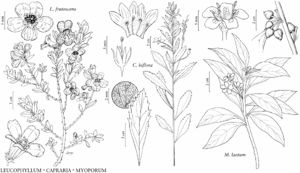Leucophyllum
Pl. Aequinoct. 2: 95, plate 109. 1812.
| Taxon | Illustrator ⠉ | |
|---|---|---|
 | Leucophyllum frutescens Capraria biflora Myoporum laetum | Linny Heagy Linny Heagy Barbara Alongi |
Shrubs; stolons absent. Stems erect, well branched, densely silvery-gray-tomentose, hairs conic to cylindric, dendritic, sometimes appressed-stellate, glabrescent, [glabrous and sessile-glandular]. Leaves persistent, cauline, alternate to opposite or subopposite; stipules absent; petiole usually present; blade plane or ± conduplicate, not fleshy, not leathery, margins entire. Inflorescences axillary, flowers solitary; bracts absent. Pedicels present; bracteoles absent. Flowers bisexual; sepals 5, calyx radially symmetric, campanulate, lobes linear to oblong-lanceolate or oblong; petals 5, corolla purplish lavender to violet or blue, rarely white, with white in proximal throat, usually marked with yellowbrown, orange, or purple-violet spots, slightly bilaterally symmetric, funnelform-campanulate, abaxial lobes 3, adaxial 2, adaxial lip with lobes slightly smaller than abaxial; stamens 4, adnate to proximal 1/4–1/3 of corolla-tube, didynamous, filaments glabrous or pilose near base, staminode 0; ovary 2-locular, placentation axile; stigma 2-lobed. Fruits capsules, oblong-ovoid, dehiscence initially septicidal to near base, eventually loculicidal halfway to base. Seeds 15–25, yellowish-brown, irregularly ovoid, minutely reticulate, wings absent. x = 17.
Distribution
sc United States, Mexico
Discussion
Species 15 (3 in the flora).
Leucophyllum is closely related to Eremogeton Standley & L. O. Williams of southern Mexico and Central America and Capraria of tropical southern Florida, Mexico, the West Indies, and Central and South America. Studies by E. Gándara and V. Sosa (2013) show both Capraria and Eremogeton imbedded within Leucophyllum in chloroplast and chloroplast-dominated phylogenies, but not in their nuclear (ITS) phylogeny (pers. comm.), leaving the relationship of these taxa unresolved.
The relationship of Leucophyllum with Myoporaceae often has been suggested (L. D. Flyr 1970b; C. J. Niezgoda and A. S. Tomb 1975; E. E. Karrfalt and Tomb 1983). Molecular studies recognize Myoporeae and Leucophylleae as sister tribes within the redrawn Scrophulariaceae (R. G. Olmstead et al. 2001; B. Oxelman et al. 2005).
Leucophyllum zygophyllum I. M. Johnston is mapped in Hidalgo County, Texas (B. L. Turner et al. 2003); the voucher, deposited at TEX, was most likely collected in Mexico.
Selected References
None.
Key
| 1 | Leaves: abaxial surfaces silvery gray, adaxial more greenish; plants 5–20(–30) dm; sc to trans-Pecos Texas. | Leucophyllum frutescens |
| 1 | Leaf surfaces equally silvery gray; plants 2–10(–15) dm; trans-Pecos Texas. | > 2 |
| 2 | Young stems and leaves densely and evenly silvery, hairs stellate, closely and tightly appressed, densely overlapping; plants often appearing thorny. | Leucophyllum minus |
| 2 | Young stems and leaves irregularly canescent-tomentose, hairs conic to cylindric, dendritic, uneven in height; plants not appearing thorny. | Leucophyllum candidum |